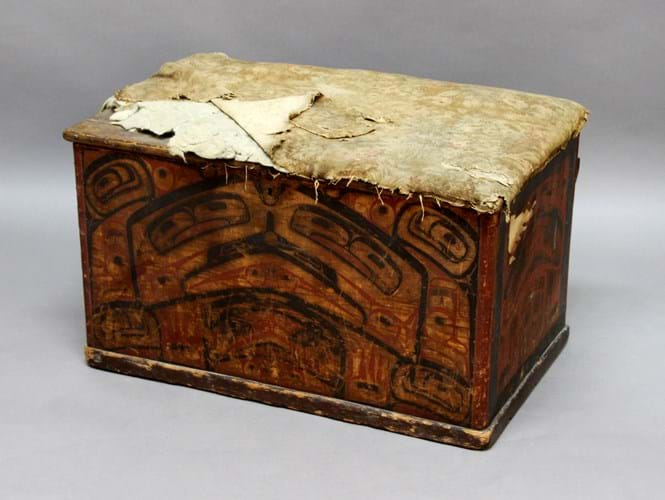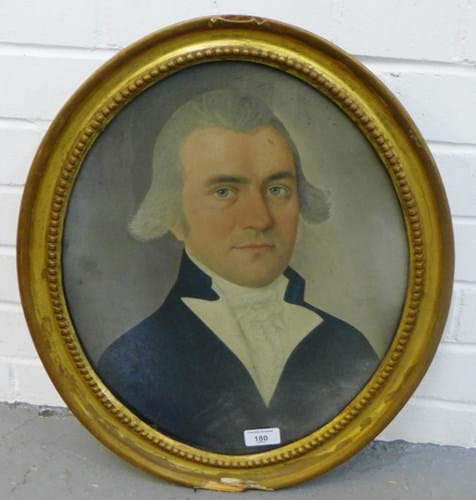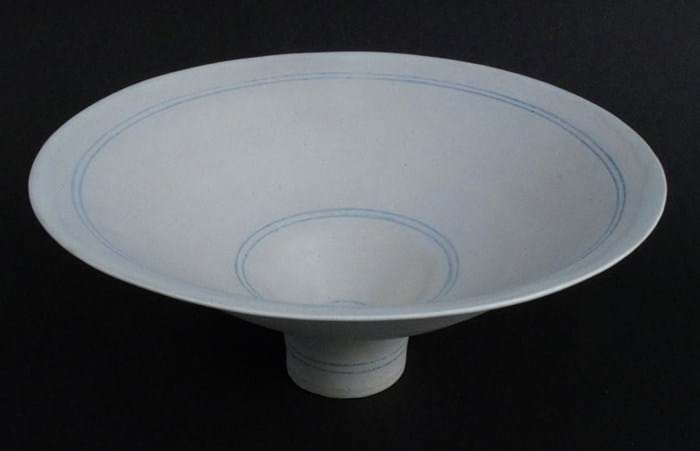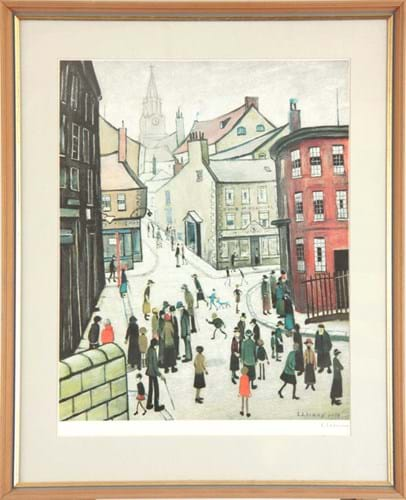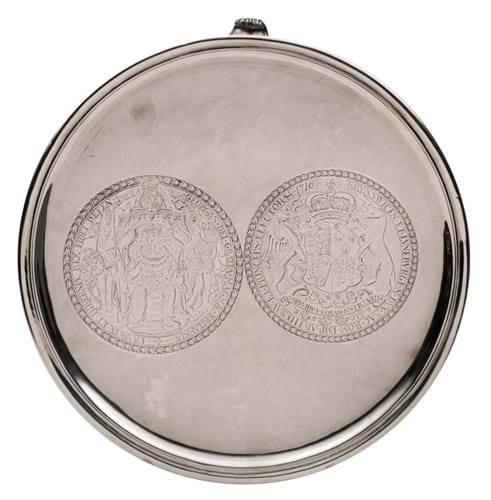1. Native American cedar chest – £19,000
Although outwardly simple objects, cedar ‘bent corner’ chests, still made today by the indigenous people of the Pacific North West, employ a number of sophisticated woodworking techniques.
A single seasoned timber board is adzed to shape, kerfed in the three places and then steamed, bent and pegged at the join. The front and back sides are then painted with stylised animal designs personal to the owner and their family. Kept as family heirlooms, they were used primarily for storage of food or as watertight cooking vessels. Some were traded or given as gifts at potlatches.
Rarely do antique examples used in a domestic context by the Haida or Tlingit peoples appear for sale.
However, one dating from the 19th century or possibly earlier emerged for sale at Lawrences of Crewkerne on January 17. It had initially made its way into one of the auctioneer’s general sales but had been upgraded to the catalogued sale. Given only a small catalogue illustration, a single line description, it was spotted by a number of potential buyers as something worth way beyond the £300-500 estimate.
It ultimately sold at £19,000 to a Canadian bidder.
2. Sea captain’s portrait – £3800
This portrait of a Western merchant or sea captain is in the manner of Guan Zuolin, a China trade artist active in Canton between c.1785-1810. He is known in the West as Spoilum.
Working in oil and canvas in the Eastern style his many portraits of Western merchants typically required a two- or three-hour sitting, and cost $10.
The unsigned head and shoulders portrait in a glazed giltwood frame measuring 16.5 x 13.5in (42 x 34cm) – the size of other autograph works by the artist – came for sale at Edinburgh saleroom Franklin Browns on January 18 where, estimated at £30-50 it took £3800. A firmer attribution to Spoilum could make the price appear modest.
3. Lucie Rie bowl – £46,000
The most commercially desirable of all the pots by made Lucie Rie at her studio in Albion Mews, Paddington are the series of flared footed bowls inspired by vessels of the Song dynasty. Today, in a burgeoning market for the best British studio pottery, the most appealing examples have become very expensive indeed.
An impressive £46,000 was bid at the Malvern saleroom of Philip Serrell on January 16 for this 9in (23cm) white porcelain bowl with a matte white glaze and concentric inlaid blue lines repeated inside and out. It came for sale together with its original receipt from Rie’s dealer, the Peter Dingley Gallery, Stratford-on-Avon, dated 1983. Its only imperfection were a series of flea bite chips to the base and minor blemish to the foot rim that occurred when the bowl was fired. The estimate was £6000-9000 and the winning bid came via thesaleroom.com.
It is almost identical to the bowl pictured on the front cover of Tony Birk’s 1994 biography of Lucie Rie and another dated c.1978 sold for a massive $170,000 (£134,000) at Phillips New York in December 2016 – the auction record for any Rie pot.
4. LS Lowry lithograph – £9100
With its many figures and buildings and the North East coast subject, Berwick-on-Tweed is one of the most desirable of all LS Lowry lithographs. It was published by the Fine Art Guild (whose blind steps appear lower left) in 1973 in a relatively large edition of 650.
All of the 21 x 17in (55 x 43cm) prints are signed by the artist. They come up at auction with some frequency: in September 2019 one made £9000 at Byrne’s in Chester; another took £8800 at Tennants in Leyburn in October, followed in November by a third sold for £9000 at Reeman Dansie in Colchester.
The example pictured here was offered at Hutchinson Scott in Skipton on January 16. Estimated at £3000-5000, it pipped the previous three prices selling at £9100.
5. Portrait of a jester – £15,500
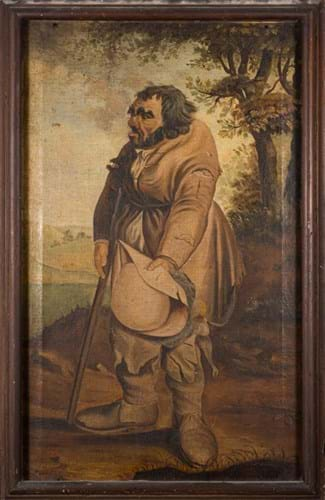
An 18th century English provincial school portrait of the jester Black John, £15,500 at Bearnes Hampton & Littlewood.
This 18th century English provincial school full-length portrait depicts the jester Black John. He was in the employ of the famously eccentric John Arscott (1718-88) of the Tetcott estate in Devon, said to be the last man in England to keep a professional jester.
Black John, who had dwarfism and was under four foot in height, was famous for his after-dinner tricks that included swallowing and retrieving several live mice tied to a string and stripping a live sparrow of its feathers while his hands were tied behind his back.
Black John was so attached to his master that, after his death, he built a shelter close to the church at Tetcott where, with an old hound as his sole companion, he reputedly grieved away the remainder of his life. It was said he died of a broken heart.
The 3ft 5in x 2ft 1n (1.03m x 62cm) oil on canvas that emerged for sale at Bearnes Hampton & Littlewood in Exeter on January 21 with an estimate of £800-1200 was seemingly a copy of James Northcote’s (1746-1831) portrait of the same subject that is now in the Royal Cornwall Museum.
Admired for both its folk art charm, unusual subject matter and as a quirky piece of local history, it sold at £15,500 to a bidder using thesaleroom.com.
6. George I Irish silver salver – £9400
Upon the death of the monarch, or when a statesman left office, it was required by law that any seals of royal authority be broken and defaced. Typically they were then given to the last holder of that high office – a considerable perk as many were made with 20-plus ounces of silver bullion.
It became the custom by the 17th century for the recipient to commission leading silversmiths of the day to turn the defaced seal into a piece of plate incorporating an engraved version of the original seal. The most famous of these is the salver featuring the Second Exchequer Seal of George I made by Paul de Lamerie for Robert Walpole in 1728, now in the Victoria and Albert Museum.
This 29oz, 12in (30cm) George I Irish salver, offered for sale at Bearnes Hampton & Littlewood in Exeter on January 21 with an estimate of just £300-500, appears to be another survivor.
It had been in the same family for at least three generations but had no earlier history. Engraved with the royal coat of arms and the obverse with the great seal of George I, it is struck with marks for Dublin 1727 but carries no maker’s mark.
As it had been later converted from a tazza and new scroll feet added, specialist Martin McIlroy informed the vendor that it could not be legally sold without evaluation by the Antique Plate Committee at Goldsmiths Hall. The Committee decided that the Irish marks could stay but the feet should be struck with London Assay Office marks for 2019. The latter may have reduced its commercial appeal but not by too much: it sold to a UK private collector at £9400 (plus 23% buyer’s premium), some 19 times the pre-sale guide.


